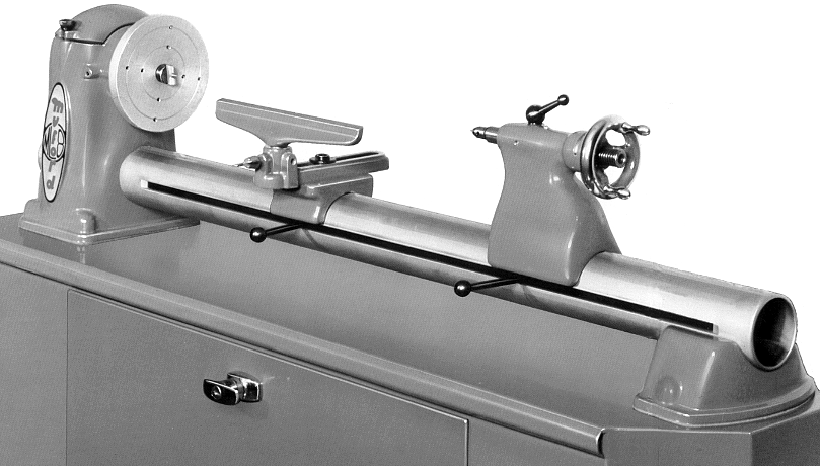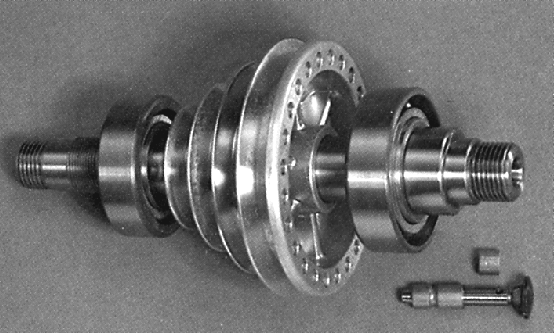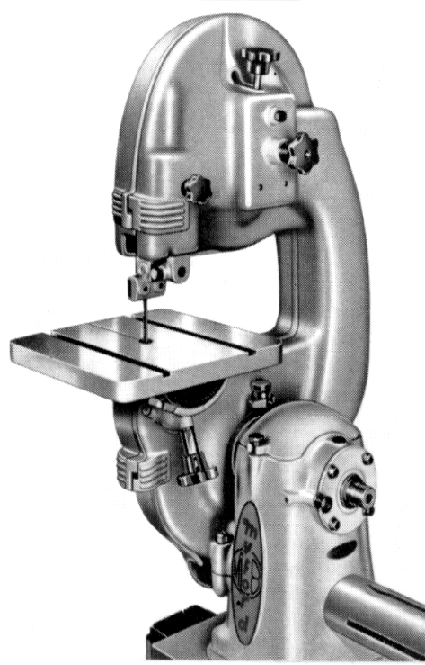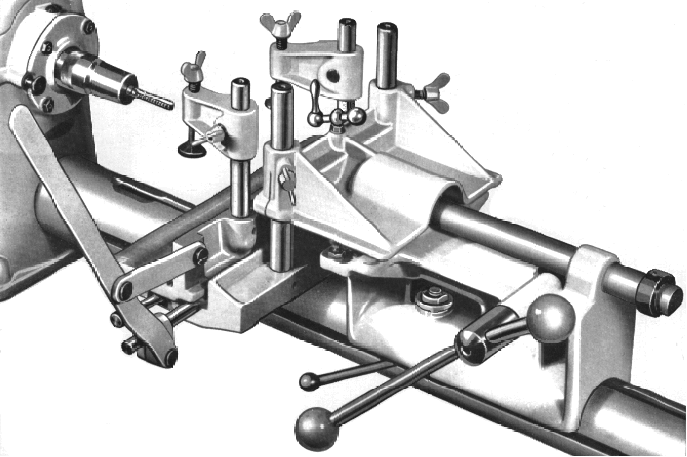Learning to turn? Selected from dozens,
here is the very best book you can buy
The ML8 was not Myford's first dedicated wood lathe (this had been built in the late 1930s, but with production interrupted by the start of WW2) and was designed and patented by Edward Barrs, the man also responsible for the ML7 and who went on to become Managing Director of the Company. Introduced in the late 1940s, the lathe patent was applied for in January 1947 and granted - with the number GB620276 - in 1949.
Neat, well-made and beautifully finished, this 4-inch centre-height lathe enjoyed a large and loyal following and continued in production until the mid-1980s. The earliest versions were painted cream, from June 1960 in silver and the last, thought to have been from some point in the early 1970s, in a rather pleasing shade of light green. However, one early lathe was not yellow, but supplied in green to a Mr. Emmans, his son who now owns the lathe writes, "The Model Engineers Exhibition was held annually in the Royal Horticultural Hall in Westminster. My father and I went for several years if only to meet up with my uncle, Edward (Ted) Barrs, then a fairly 'big noise' at Myford's Beeston. As you know, he became MD and held that post till retirement. On one of our annual excursions, Dad did a deal with Uncle Ted and bought the green lathe on display, complete with the rear turning attachment. Subsequently, he was to buy the Bandsaw attachment and the outboard sanding table, both these being in the standard yellow. On the Myford stand at the exhibition, Ted introduced me to Mr Fred Payne, Myford's wood-turning demonstrator. Mr Payne taught me more in the hour or so that I was with him than I could ever have learnt at school."
Intended for economical production, the lathe had a bed made from a length of seamless, drawn steel tube (in an attractive, dull nickel-plated finish), and could be had in three standard capacities of 30, 36 and 42 inches between centres. A standard 30-inch machine was catalogued as the ML8 but, when fitted with bowl turning, became the ML8A and, with 36 and 42-inch beds as, respectively, the ML8B and ML8C. There was also a special short-bed version, the ML8S, that lacked a tailstock and is normally found mounted on a simple, silver-painted underdrive stand constructed from light angle-iron with a pressed-steel top and complete with outboard bowl turning and a metal-working compound slide rest from the metal-working ML7. Another equally rare version was the ML8 "ML8 Universal Woodworker", this being supplied on a cabinet stand and available with a wide range of accessories including a tilting saw bench, rear and front-mounted sanding discs with tilting support tables, a 3-jaw chuck and a metal-turning compound slide assembly, a planer, a false-nose for mounting polish mops, a timber-support platform, a grindstone unit with guard, a complete bandsaw unit and a mortising attachment.
The makers also offered separate bed sections, complete with individual mounting feet, to give a maximum length capacity of 72". An important feature of the patent was the method of locking the saddle and No. 1 Morse taper tailstock to the bed - this being achieved, in both cases, by a lever that passed through a long slot cut into the front face of the bed to turn a quick-action, 2-start thread that pulled up a large clamp formed on its outside surface to the inside shape of the tube. The arrangement worked well, giving the lever a very short throw and an immediate and very strong clamping action. On the saddle was an extension to the clamping bolt that simultaneously slackened the hand T-rest assembly so allowing it to be positioned at will.
Running in angular-contact ball bearings, the No. 1 Morse taper, 13/32" bore ground-finish headstock spindle was held inside a headstock (with a simple lift-off cover) and carried a 4-step, A-section V-pulley with a ring of 24 holes to assist in dividing and marking out; the nose thread was 1" x 12 t.p.i on the right-hand side and 7/8" x 12 t.p.i on the left-hand outboard bowl-turning end. Unusually for an amateur's wood lathe, the spindle was provided with proper registers behind the threads to allow the accurate fitting of metal-working chucks and heavier faceplates. The 1425 rpm motor (0.5 hp 3-phase or 0/5 h.p and 0.75 hp 1-phase) was carried on a countershaft unit mounted underneath the lathe on a specially constructed, adjustable plate and drove upwards to the headstock spindle by a single single "link" V-belt than can be ordered here. The countershaft was designed to fit either the maker's stand or beneath a customer's own bench. Four speeds were available: 700, 1140, 1780 and 2850 rpm.
Although initially available with a wide range of accessories - mortising, planing, sawing, polishing, grinding, bandsaw and metal-turning compound slides - by the end of production (and just before the introduction of the completely different Mystro) only the basic lathe was offered. Hence, while it's not unusual to find a yellow-painted ML8 complete with all the accessories, later ones with extras are few and far between. The ML8 is often found fitted to a longer version of the braced pressed-steel stand offered for the Series 7 metal-turning lathes, this being fitted with the special, ML8-only, under-drive countershaft unit and electrical controls.
One very unusual ML8 came to light, a short-bed version that was unassembled. This had, unaccountably, the levers to lock the tool rest and tailstock to the rear of the bed. The lathe would only assemble this way round - but could the bed had been modified in some way, perhaps cut from a longer tube and turned round in the headstock. But, no, that was impossible too because the slot lengths were then incorrect. On balance, it does appear be a properly engineered and perhaps a factory special order. It was painted in the shade of light green used in the 1970s and one really does have to operate the tailstock and saddle levers by reaching over the machine. Of course, if you turn the machine round so that the headstock is to the right (as some watchmakers' lathes are) the levers come to the front - but the headstock spindle then turns in the wrong direction. The motor pulley was also mounted the 'wrong' way round too, with the large diameter a the motor end of the shaft; how very odd.





















